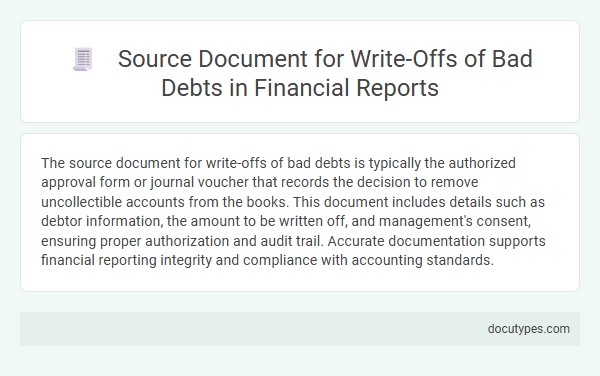The source document for write-offs of bad debts is typically the authorized approval form or journal voucher that records the decision to remove uncollectible accounts from the books. This document includes details such as debtor information, the amount to be written off, and management's consent, ensuring proper authorization and audit trail. Accurate documentation supports financial reporting integrity and compliance with accounting standards.
Introduction to Write-Offs of Bad Debts
Write-offs of bad debts occur when a company recognizes that certain receivables are uncollectible and removes them from its accounts. This process helps maintain accurate financial records by reflecting true asset values.
The source document for write-offs of bad debts is typically the bad debt write-off authorization form or journal voucher. This document provides official approval and details for removing specific receivables from the books.
Definition and Importance of Source Documents
A source document for write-offs of bad debts is the original record that provides evidence and details for the transaction. It typically includes invoices, credit memos, or correspondence related to the uncollectible amount.
Source documents are crucial because they ensure accuracy and accountability in financial reporting. You rely on these documents to validate the legitimacy of bad debt write-offs and maintain proper audit trails.
Types of Source Documents for Bad Debt Write-Offs
Source documents for write-offs of bad debts are essential records that validate the decision to remove uncollectible accounts from financial statements. Common types include customer correspondence indicating disputes or inability to pay, the original sales invoice, and approval forms signed by authorized personnel. These documents ensure compliance with accounting standards and provide audit trails for internal and external reviews.
Accounting Standards for Bad Debt Write-Offs
| Topic | Source Document for Write-Offs of Bad Debts |
|---|---|
| Definition | The source document for write-offs of bad debts is the official record that authorizes the removal of uncollectible accounts from receivables. |
| Common Source Documents | Authorization memo, management approval forms, write-off request forms, and accounting journal entries serve as primary source documents. |
| Accounting Standards | Accounting standards such as IFRS (International Financial Reporting Standards) and US GAAP (Generally Accepted Accounting Principles) guide the process and documentation for bad debt write-offs. |
| IFRS Guidelines | Under IFRS 9, expected credit loss models require entities to periodically assess and document impairment of financial assets, with write-offs supported by adequate authorization and evidence of uncollectibility. |
| US GAAP Guidelines | US GAAP mandates that write-offs occur only after the entity determines the receivable is uncollectible, supported by documentation such as correspondence, collection efforts, and approval records. |
| Importance of Source Documents | Source documents ensure accurate financial reporting, assist in audit compliance, and provide evidence for internal controls regarding bad debt management. |
| Role for You | Your responsibility includes maintaining comprehensive write-off documentation that aligns with applicable accounting standards to support financial integrity and compliance. |
Procedures for Identifying Uncollectible Accounts
The source document for write-offs of bad debts is typically the aging report or an accounts receivable ledger that identifies overdue accounts. These documents provide detailed information on outstanding customer balances and help determine which accounts are uncollectible.
Procedures for identifying uncollectible accounts involve reviewing the aging report to pinpoint accounts past due beyond a specified period, often 90 days or more. You analyze customer payment history, communication attempts, and any financial difficulties that may impact collection. This process ensures accurate documentation before authorizing write-offs of bad debts.
Documentation Required for Bad Debt Write-Offs
The source document for write-offs of bad debts primarily includes detailed accounts receivable records and formal approval notes from authorized personnel. Essential documentation required for bad debt write-offs consists of the original customer invoice, evidence of collection efforts, and a written authorization or approval form validating the decision. You must ensure all records are complete and accurate to maintain compliance and support financial reporting.
Approval and Authorization Processes
The source document for write-offs of bad debts serves as the official record for approval and authorization. It ensures all write-offs comply with company policies and financial regulations.
- Approval Authorization Form - This document requires signatures from authorized personnel to validate the approval of bad debt write-offs.
- Credit Management Report - Provides detailed information on the debtor's payment history and justification for the write-off request.
- Financial Controller's Review - A formal review process where the financial controller assesses and authorizes the write-off based on company guidelines.
Recording Bad Debt Write-Offs in Financial Reports
The source document for write-offs of bad debts is essential for accurate financial reporting and audit trails. Recording bad debt write-offs properly ensures compliance with accounting standards and maintains the integrity of financial statements.
- Identification of Uncollectible Accounts - The source document typically originates from an accounts receivable aging report that highlights overdue and uncollectible customer balances.
- Authorization of Write-Offs - Approval is documented by management or an authorized personnel through a formal write-off request or memo confirming the debt's uncollectibility.
- Journal Entry Documentation - The final source document is the journal voucher or entry record that posts the bad debt expense and reduces accounts receivable in the general ledger.
Internal Controls and Audit Trail Maintenance
The source document for write-offs of bad debts is a critical component in ensuring accurate internal controls and maintaining a clear audit trail. Proper documentation supports transparency and accountability in the financial process.
- Write-Off Authorization Form - This document formally approves the debt write-off and is essential for internal control verification.
- Customer Account Records - Detailed transaction history and correspondence justify the decision to write off the bad debt.
- Audit Trail Logs - Maintains a record of all actions taken related to the write-off, supporting audit requirements.
You must ensure these source documents are complete and properly filed to uphold financial integrity and compliance.
What Is the Source Document for Write-Offs of Bad Debts? Infographic

